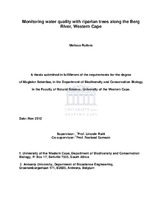Monitoring water quality with riparian trees along the Berg River, Western Cape
Abstract
Heavy metals and nutrients have long been regarded as pollutants to freshwater ecosystems. These elements have a detrimental effect on plants, animals and the water quality of rivers in South Africa. The Berg River flows from the mountains of Franschhoek to the West Coast of the Western Cape. It is an important river in Cape Town, as it is essential for water distribution to town, for agriculture and industry and also supports a rich diversity of organisms in the ecosystem. Along the river, many farms and towns are situated and many tributaries enter the river. The Berg River dam provides for a water supply during the drier periods of the year. Therefore it is crucial to maintain a good water quality. The study was driven by the need to increase the knowledge of water quality in the upper Berg River after the construction of a new major Berg River dam, constructed in 2007. This study investigated oxygen, water temperature, electrical conductivity, pH, ammonium, nitrate, nitrite in the water and cadmium, copper, lead, iron, zinc, potassium, sodium, calcium, magnesium and phosphorus found in water, sediment and three plant species at ten sites along the upper Berg River, Western Cape. The results showed that the electrical conductivity, pH and the concentrations of nitrate, calcium and magnesium increased downstream, whereas the water temperature decreased downstream. Nitrate, cadmium, copper, potassium, sodium, calcium and magnesium displayed a general increase towards the colder period in the water. Seasonally, copper and magnesium showed significant winter increase within the sediment. Nitrogen, iron and calcium levels within Salix sp., Acacia mearnsii and Brabejum stellatifolium increased downstream. Nitrogen, cadmium, copper, potassium, calcium, magnesium and phosphorus in the three species were higher in the warmer seasons and decreased in the colder. Sources of pollution stem from the Franschhoek and Dwars tributaries, urban and farm runoff.

